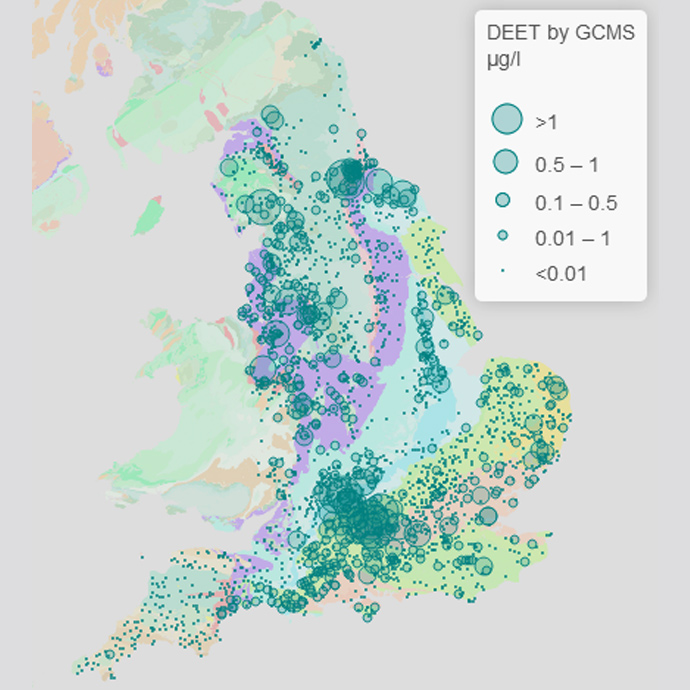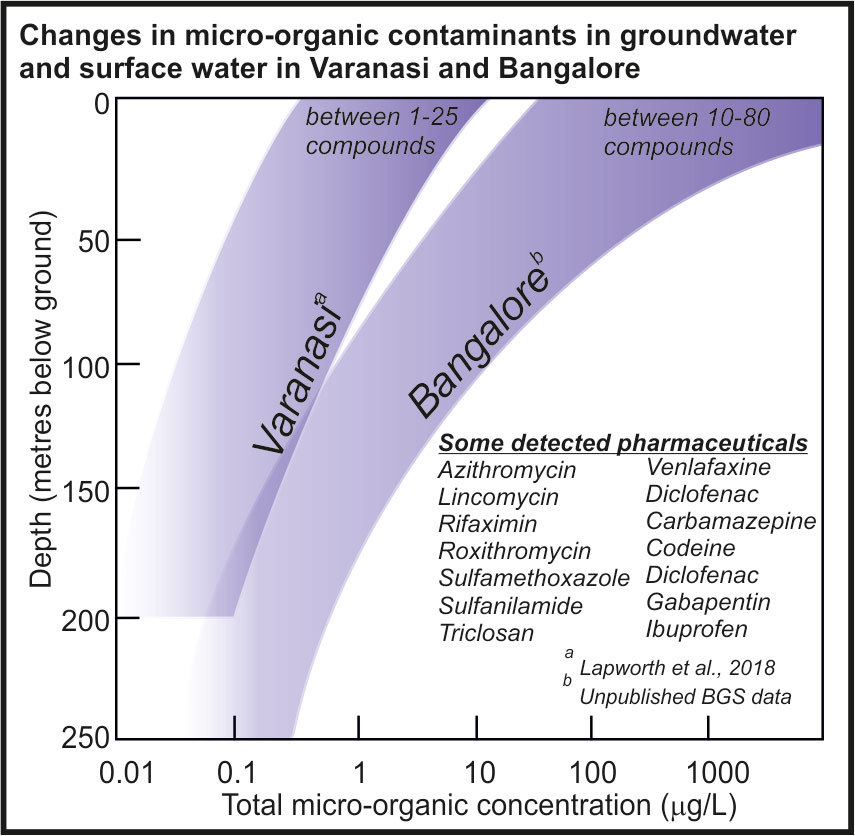The term ‘emerging contaminants‘ is used to describe substances which are not yet regulated but may be of environmental or human health concern. These substances include medicines, personal care products and industrial compounds such as plasticisers. Emerging contaminants found in English groundwater include the medicines ibuprofen (painkiller and anti-inflammatory) and carbamazepine (used to treat epilepsy).
Our expertise in sampling and analytical technique development, data analysis and interpretation and policy development has been applied in the UK and internationally, at local and national scales. Our groundwater experts are working with European partners to develop a groundwater watch list for substances of emerging concern.
Our projects
Screening programmes are employed by the Environment Agency (EA) to look at a wide range of compounds including many that are not currently regulated. We summarised their data (to 2017) for groundwater in England and identified the most frequently detected compounds and those detected at the highest concentrations.
The insect repellent DEET was the seventh most frequently detected compound (by gas chromatography mass spectrometry (GCMS) screen), being detected in over five per cent of samples. Pharmaceuticals such as carbamazepine and clopidol were detected in over a third of samples analysed by liquid chromatography mass spectrometry (LCMS) screen.
We are working with European colleagues to assess the state of knowledge of emerging contaminants in European groundwater. This work forms part of the European Union’s Horizon 2020 research and innovation programme GeoERA (project HOVER). We are working together to consolidate current understanding and identify effective future action on this important topic.
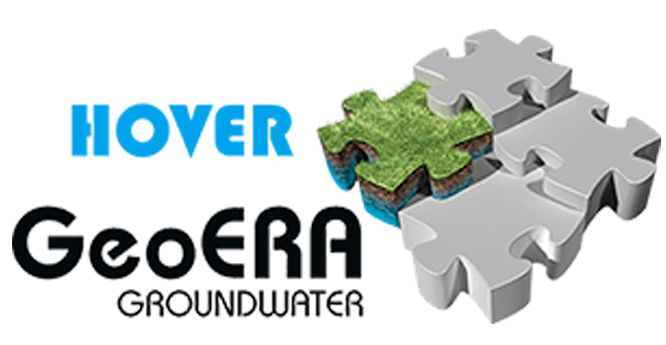
There are so many emerging contaminants, it is necessary to prioritise which to regulate. We have worked with European partners to develop a methodology that ranks candidate substances on the basis of their occurrence, persistence, mobility and potential toxicity and bioaccumulation behaviour.
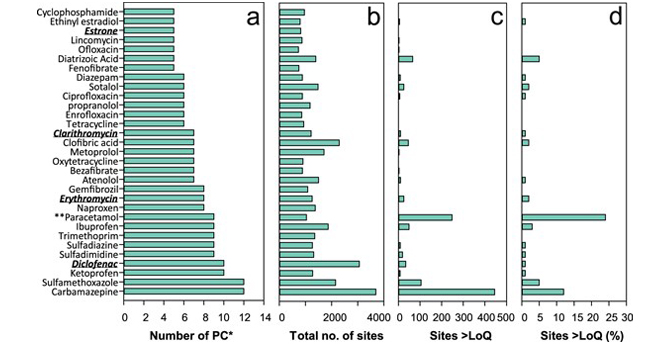
Pharmaceutical substances detected in groundwater in five or more participating countries: (a) number of participating countries with findings; (b) total number of sites analysed; (c) number of sites with detections >LoQ; (d) % of sites with detections >LoQ. Source: Marsland and Roy (2016). Substances highlighted in bold italics are on the surface water watch list. *Participating countries; ** also referred to as acetaminophen. From Lapworth et al., 2019.
We have worked with an extensive network of colleagues in Europe (Lapworth et al., 2019), Zambia (Sorensen et al., 2015), India (Lapworth et al., 2018b) and New Zealand (Moreau et al., 2019) to characterise the occurrence of pharmaceuticals, personal care products and other emerging contaminants in groundwater and surface water used as drinking water.
This work has found a wide variety of potentially harmful, as yet unregulated, contaminants liked to hot spots of anthropogenic activity. These chemicals have also been used effectively as tracers to understand groundwater recharge sources and pathways in groundwater–surface water interaction.
Definition of ’emerging contaminant‘
Groundwater can contain a wide range of components, including those that are naturally occurring and those that come from a human source; some of these have the potential to harm the environment or human health. Regulations set limits for certain parameters. The term ’emerging contaminant’ is used to describe a substance that is not yet regulated but may be of environmental or human health concern. Synonyms include ‘substances of emerging concern’.
Although these compounds are typically present at low concentrations, they are often able to pass through water treatment.
What types of compounds have been identified in groundwater?
The types of emerging contaminants which have been found in groundwater worldwide include:
- caffeine and nicotine and their metabolites
- flame/fire retardants and surfactants
- industrial additives and byproducts
- nanomaterials (very small particles)
- personal care products and fragrances
- pesticides and their metabolites or breakdown products
- pharmaceuticals and hormones, including veterinary medicines
- water treatment byproducts
How does contamination get into groundwater?
There is a wide variety of sources and pathways that allow these compounds to enter the environment. Sources include agriculture, livestock farming, industry, waste disposal and urban areas.
Pathways to groundwater include leaching from cultivated areas or animal wastes, effluent discharged from waste-water treatment works into ponds that infiltrate to groundwater or to surface water, which then interacts with groundwater.
Many of the compounds are relatively small, polar molecules that are not effectively removed by conventional drinking-water treatment.
References
Ascott, M J, Lapworth, D J, Gooddy, D C, Sage, R C, and Karapanos, I. 2016. Impacts of extreme flooding on riverbank filtration water quality. Science of the Total Environment, Vols. 554–555, 89–101.
Gaston, L, Lapworth, D J, Stuart, M, and Arnscheidt, J. 2019. Prioritisation approaches for substances of emerging concern in groundwater: a critical review. Environmental Science & Technology, Vol. 53(11), 6107–6122.
Lapworth, D, and Stuart, M. 2012. The challenge of emerging groundwater contaminants. Groundwater Newsletter, Vol. 50, 28–31.
Lapworth, D J, Lopez, B, Laabs, V, Kozel, R, Wolter, R, Ward, R, Vargas-Amelin, E, Besien, T, Claessens, J, Delloye, F, Ferretti, E, and Grath, J. 2019. Developing a groundwater watch list for substances of emerging concern: a European perspective. Environmental Research Letters, Vol. 14(3), 035004.
Lapworth, D J, Crane, E J, Stuart, M E, Talbot, J, C, Besien, T, and Civil, W. 2018a. Micro-organic contaminants in groundwater in England: summary results from the Environment Agency LC-MS and GC-MS screening data. British Geological Survey Open Report OR/18/052. (Nottingham, UK: British Geological Survey.)
Lapworth, D J, Das, P, Shaw, A, Mukherjee, A, Civil, W, Petersen, J O, Gooddy, D C, Wakefield, O, Finlayson, A, Krishan, G, Sengupta, P, and MacDonald, A M. 2018b. Deep urban groundwater vulnerability in India revealed through the use of emerging organic contaminants and residence time tracers. Environmental Pollution, Vol. 240, 938–949.
Lapworth, D J, Baran, N, Stuart, M E, Manamsa, K, and Talbot, J. 2015. Persistent and emerging microorganic contaminants in Chalk groundwater of England and France. Environmental Pollution, Vol. 203, 214–225.
Lapworth, D J, Baran, N, Stuart, M E, and Ward, R S. 2012. Emerging organic contaminants in groundwater : a review of sources, fate and occurrence. Environmental Pollution, Vol. 163, 287–303.
Manamsa, K, Crane, E, Stuart, M, Talbot, J, Lapworth, D, and Hart, A. 2016. A national-scale assessment of microorganic contaminants in groundwater of England and Wales. Science of the Total Environment, Vol. 568, 712–726.
Manamsa, K, Lapworth, D J, and Stuart, M E. 2016. Temporal variability of micro-organic contaminants in lowland chalk catchments: new insights into contaminant sources and hydrological processes. Science of the Total Environment, Vol. 568, 566–577.
Marsland, T, and Roy, S. 2016. Groundwater watch list: pharmaceuticals pilot study monitoring data collection and initial analysis report for the Groundwater Watch List Voluntar Group, undertaken by AMEC FosterWheeler. (Assessed: May 2018.) 1.1MB .doc.
Moreau, M, Hadfield, J, Hughey, J, Sanders, F, Lapworth, D J, White, D, and Civil, W. 2019. A baseline assessment of emerging organic contaminants in New Zealand groundwater. Science of the Total Environment, Vol. 686, 425–439.
Sorensen, J P R, Lapworth, D J, Nkhuwa, D C W, Stuart, M E, Gooddy, D C, Bell, R A, Chirwa, M, Kabika, J, Liemisa, M, Chibesa, M, and Pedley, S. 2015. Emerging contaminants in urban groundwater sources in Africa. Water Research, Vol. 72, 51–63.
Stuart, M E, Lapworth, D J, Thomas, J, and Edwards, L. 2013. Fingerprinting groundwater pollution in catchments with contrasting contaminant sources using microorganic compounds. Science of the Total Environment, Vols. 468–469, 564–577.
Stuart, M, Lapworth, D, Crane, E, and Hart, A. 2012. Review of risk from potential emerging contaminants in UK groundwater. Science of the Total Environment, Vol. 416, 1–21.
Stuart, M E, Manamsa, K, Talbot, J C, and Crane, E J. 2011. Emerging contaminants in groundwater. British Geological Survey Open Report OR/11/013. (Nottingham, UK: British Geological Survey.)
White, D, Lapworth, D J, Civil,W, and Williams, P. 2019. Tracking changes in the occurrence and source of pharmaceuticals within the River Thames, UK: from source to sea. Environmental Pollution, Vol. 249, 257–266.
White, D, Williams, P J, Civil, W, and Lapworth, D J. 2017. A field based method for pre-concentration of microorganics using solid phase extraction. British Geological Survey Open Report OR/17/011. (Nottingham, UK: British Geological Survey.)
White, D, Lapworth, D J, Stuart, M E, and Williams, P J. 2016. Hydrochemical profiles in urban groundwater systems: new insights into contaminant sources and pathways in the subsurface from legacy and emerging contaminants. Science of the Total Environment, 562. 962–973.
Contact
If you want to discover more then please contact Dan Lapworth.
You may also be interested in
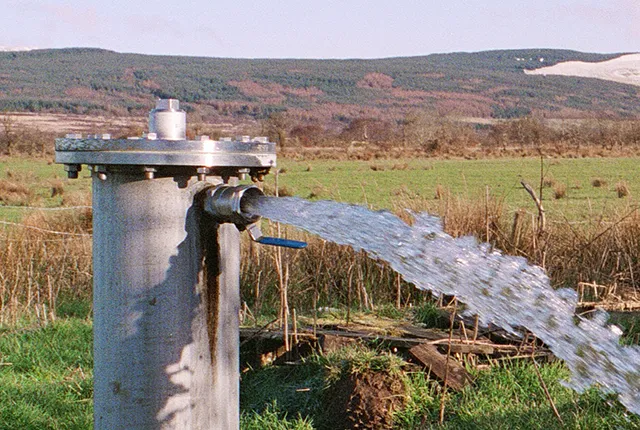
Groundwater research
Addressing issues related to the sustainability of water resources and quality, and the effects of environmental change on the water cycle, natural hazards, and human health.
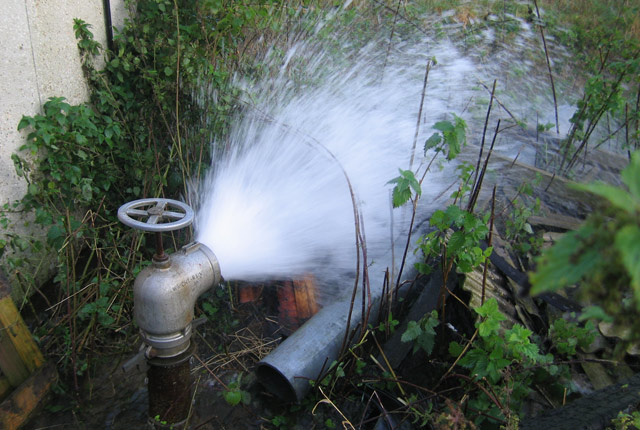
Groundwater quality
The quality of groundwater determines its value as a resource and its impact on surface water ecosystems. BGS researches all aspects of groundwater quality.


